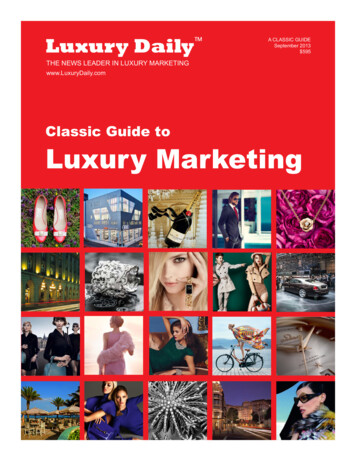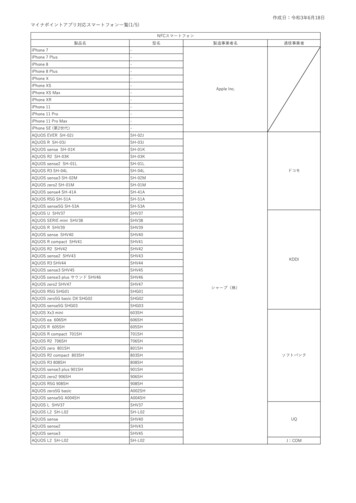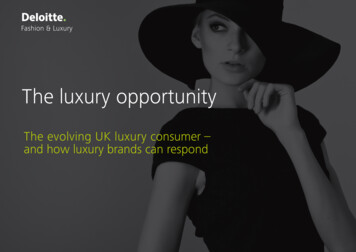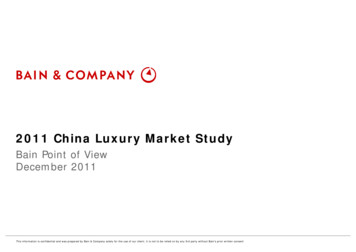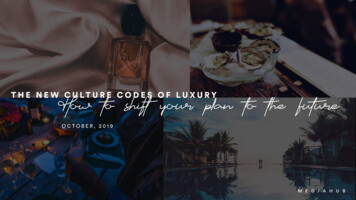
Transcription
How to shift yo! plan to the f"!eT H E N E W C U LT U R E C O D E S O F L U X U R YOCTOBER, 2019
It’s time to stop talking about traditional luxury advertisingbecoming more and more ineffective, and actually start tomarket differently and betterFor the past handful of years, we have been settling into the new reality that people are consuming all content,including luxury, very differently: in their social feeds, across their devices, on their own time. As marketers, wehave become the frog in the boiling pot by not truly shifting our thinking, our spending, and our strategies. Thenumbers speak for themselves, embracing these undisputed facts:40–50%OF LUXURY ADVERTISING SPEND IN THE U.S. IS EXPECTEDTO GO TO MAGAZINES THIS YEAR, WHEREAS OTHERCATEGORIES ARE EXPECTED TO SPEND 5–10%.We wistfully hold on to strategies of the past,convincing ourselves with statements like “We’ve stillgot the Sunday Times” and “The September issuesalways have a lot of eyeballs.” And while those can bestill viable placements for any luxury media plan, theyare becoming fewer and fewer, and lessimpactful. Take a look at the fall fashion books whichhave just arrived at the newsstands. Vogue single-saleSeptember copies have decreased by 38% in the pastfive years — it’s safe to say consumers flush withmoney are no longer standing in line waiting todiscover the “must haves” of the season.In our latest luxury Scout custom study, we wanted tounearth how luxury brands should think about“media” in an environment where the future does notfit into containers of the past. We found that in theSource: Mediahub Scout Custom Luxury Study, Kantar Mediahunt for personal connection and authenticity,consumers are moving away from the typical industryinsiders as trusted sources of influence inluxury. What we started to unearth in this study was avery interesting dichotomy: The number one placerespondents feel luxury brands belong is at fashionevents (34%), followed by luxury magazines (33%).That said, no demographic pointed to these spacesas highly influential on their actual purchasedecisions, with only 12% acknowledging the influenceof magazines on luxury choices, and only 10% inrespect to fashion week. Their sources of influenceare grounded in the highlight reel of social media. Somagazines still have a place in a luxury media plan,but do not drive the same number of eyeballs(everybody knows that) and, more importantly, donot carry the same influence.!2
Gone are the days of untouchable models being the height of inspiration; consumers are looking for a newlayer of velocity, flair, and realness as they seek out inspiration. No longer can brands guarantee success byspending millions on gatefolds and cover fours or by blanketing downtown Soho or Williamsburg with highimpact outdoor. Through our research, we have come to understand that traditionally trusted media venuesof luxury have perceived authority, but it is the always-on feed that has the ultimate influence and power.If you’re asking yourself the question,“How can I break throughthe scroll?"We hear you. We believe you can connect more deeply outside of the Instagram montage too. Webelieve a modern approach honors consumers new expressions and new connections to luxury. So,marketers and CMOs, here are ten ways you can embrace and empower today is and tomorrow’s luxuryconsumer through a new kind of marketing plan that looks beyond traditional venues and beyond thesocial media filter.Source: Mediahub Scout Custom Luxury Study!3
SummaryExecutiveHow luxury brands win in thenew and ever-changing environmentSource: Mediahub Scout Custom Luxury Study, Kantar Media1LUXURY IS WHAT YOU OWN WHO YOU ARE. Personal fulfillment through luxury is shiftingthe tide from conspicuous consumption to new forms of luxury, and consumers are lookingfor brands to get more personal in their journey toward growth and self-exploration.2UNDERSTAND THAT SELF-CELEBRATIONS MATTER MOST. Luxury consumers are embracingluxury as a method of self-love beyond classic milestone moments—and brands need toshift to fit into this exploding model of self-celebration 365 days of the year.3BROADEN YOUR IDEA OF WANDERLUST. It’s a mentality that goes far beyond vacation—onethat is exploration-driven and curiosity-first. Embrace travel as bigger than a trip andbecome a partner in their wanderlust.4PLUS UP POWER DYNAMICS. Rising generations are looking to new-school purveyors ofluxury, from feminists to politicians to activists, and they aren’t impressed by diverserepresentation in luxury—they expect it.5ELEVATE NEW PLAYERS IN THE GAME. Gen Z is 54% more likely than other audiences toturn to gamers for luxury inspiration—and streetwear, music, and apparel are becomingmore intertwined in the space than ever before.!4
SummaryExecutiveHow luxury brands win in thenew and ever-changing environment6START BUILDING A NEW TYPE OF CLOUT in a category that has previously really stood for“empty luxury:” 91% of respondents say luxury brands should rally behind social causes, andthis new and heightened criteria is being reinvented by young consumers.7SAVE THE PLANET SAVE YOUR BRAND. In 2020 and beyond, sustainability needs to meanmore to your brand than just a logo slap or one-off donation, so explore the corners of yourbrand that can own environmental-first brand stands.8BRING BESPOKE TO AI, NOT ATELIERS. Recognize personalization is no longer having yourname on a luxury item—it’s a tech and entertainment curated experience that makes risingaffluents feel seen and heard.9SHARE MORE THAN A GLOSSY PHOTO. Social beyond the big three is finding a spot on thefront screen as new generations go deeper into new inspiration threads of the Internet, andmove beyond visual browsing for a deeper level of engagement in the feed.10Source: Mediahub Scout Custom Luxury Study, Kantar MediaADOPT A “STREAMING” MINDSET TOO. To reach new heights with holistic viewers,incorporate activations (not just ads) into your video strategy—rally behind streaming TVshows to find new moments of connection that go far beyond a commercial.!5
who you areLuxury is what you ownLuxury is moving from basic badging to “symbols of the self,” and brands can play a rolein this journey to self actualization. 61% of respondents stated that luxury is not aboutprojecting an image, and is instead about looking inward. This transition toward selfactualization through luxury has transformed the consumer’s approach to the category,moving away from pure indulgence and toward moments of personal fulfillment.With this focus on self-growth comes a distinct spotlight on the values, goals, andfeelings that luxury brands evoke. Consumers are no longer looking for untouchablebrands that purvey indulgence and exclusivity; rather, they’re looking for brands to getmore personal in their journey toward growth and self-exploration. This shift of luxurybrands as a partner in the journey toward self-discovery resonates with consumers, whoare hungry for a modern lens on luxury.1And we’re seeing an impact on how consumers follow trends:78%OF CONSUMERS SAY THAT THEYPURCHASE LUXURY FORTHEMSELVES, RATHER THANFOLLOWING THE LATEST TREND.73%OF CONSUMERS SAY THATWEALTH AND MATERIALTHINGS SHOULD BEUNDERSTATED.A parody of the 2019 luxury mindsetSource: Mediahub Scout Custom Luxury Study
who you areLuxury is what you ownAs luxury becomes something much larger than badge flashing, we see “wellness”become deeply entwined with luxury categories. Even categories that havetraditionally been associated with indulgence are beginning to follow theconsumer trend of thoughtful moderation. 66% of Millennial drinkers say they’dlike to drink less alcohol, and brands are responding to this heightened need for apersonalized experience by tweaking product offerings to honor major wellnessmovements. Ketel One and Diageo-owned Seedlip are speaking to consumersdirectly as they craft products tailored to the sober-curious movement, withlowered ABV or no alcohol. This type of personalized drinking experience,tailored to the Millennial movement toward thoughtful consumption, elevates thecategory to an experience that feels made-for-them, creating a moment they’llremember rather than a drink that they’ll forget. And this mindset is transformingthe most popular music festivals around the world. Wellness is increasinglybecoming the supporting act to music, a far cry from the hard-partying reputationthat many festivals used to carry. Famed luxe music fest Coachella is includingincreased wellness experiences at their festivals, offering everything from veganramen to sound baths—and consumers are embracing this, with conversationincreasing 58% year over year.46%OF CONSUMERS ARE TAKINGA MORE HOLISTIC APPROACHTO WELLNESS THIS YEARSource: Mediahub Scout Custom Luxury StudyHow a Digital DetoxImproved My Health& Well-Being!7
who you areLuxury is what you ownAs consumers adopt a more holistic view of luxury tied to wellness, workingout, building healthy relationships, and getting sleep are viewed as essentialpieces of a luxury lifestyle. This focus on mindfulness is driving them to newplatforms that allow them to find balance—Apple even named mentalwellness/mindfulness apps the number one app trend of 2019. And this risingfocus on holistic wellness has promoted sleep to a status symbol, with sleepapps, DTC mattresses and Instagrammable comforters rising as the latestluxury trends. Brands thinking about leveraging the sleep obsession shouldthink about new spaces that are being created in media—ASMR video viewsgrew 122% in 2019, and sleep is now a top listening moment on Spotify. Luxuryconsumers agree that audio is a major piece of the puzzle—one in five say thatluxury brands belong on streaming radio platforms.(58%)INCORPORATINGWORKING OUT(48%)BUILDING HEALTHYRELATIONSHIPS(70%)GETTINGSLEEPTHEIR TOP PRIORITIES THIS YEARSource: Mediahub Scout Custom Luxury Study, Spotfiy, Apple!8
who you areLuxury is what you ownwhat you should doUNDERSTAND THAT THE MOVEMENT TOWARDPERSONAL FULFILLMENT THROUGHLUXURY IS SHIFTING THE TIDE FROM CONSPICUOUSCONSUMPTION TO NEW FORMS OF LUXURY.Even for Boomers, conspicuous consumption has fallen out of style; theyare 40% more likely to say that respect is more important than status.So embrace new spaces that honor this consumer mindset, like health,fitness, and sensory adventures, and explore how to push immersivewellness to new heights with emerging tech, through the use of AR, VR,and even sleep-tracking technology. Finally, honor the opportunity to bea partner to consumers as they form a whole identity, thinking beyondchannel and category to find higher meaning in the consumer journey toself-actualization.Source: Mediahub Scout Custom Luxury Study!9
matter mostUnderstand that self-celebrationsLuxury is becoming more self-centered than ever, but in a meaningful way. From liquorto watches to travel, consumers are embracing the idea of luxury as a mode of self-loveand celebration. When we asked respondents what prompted their last luxurypurchase, the number one reason for making this purchase was “a treat for myself.”And self-love isn’t limited to major calendar moments—this response was two to threetimes higher than responses for major occasions like Valentine’s Day, New Year’s Eve,weddings, and birthdays. Bottom line is, luxury purchases are now more evergreenthan ever.2Pairing self-celebration with the wider cultural conversation, we found that this bestself celebration is a true global conversation. In the last year, there were 3.2 millionsocial mentions of statements like “do you” and “living my best life.” Socialconversation has given consumers globally the permission to spend on themselves,unapologetically. And in a real way, consumers are taking "do you” to new levels byembracing “low-point moments” around them, and creating new moments of liberation.Generations today write their own rules for success, and are celebrating every step ofthe way.57%Source: Mediahub Scout Custom Luxury Study, Crimson HexagonOF 22 TO 44-YEAR-OLDS SAY“WHAT I DRINK IS AREFLECTION OF MY SUCCESS.”!10
matter mostUnderstand that self-celebrationsWith this movement toward unapologetic self-love comes boosted celebration of subtribes that were once ignored by marketers. Single people make up 45% of the U.S.population and make up a tribe 200 million strong in China. When brands pushbeyond Valentine's Day and wedding-season messaging and speak to singles directly,consumers listen. It becomes less mass and more personalized. Alibaba createdSingles’ Day a decade ago to celebrate single people, creating an e-Commercephenomenon that pulls in more than double the sales of Black Friday and CyberMonday combined.But luxury brands are just starting to show up in this massive moment of selfcelebration. And few brands have spoken to single women directly, though,culturally, single women no longer fit into the “Cat Lady” stereotype. In fact, a recentstudy by Match says one in four women says being single makes them feelempowered. It’s time for brands to wake up, and give single women a better examplethan Carrie Bradshaw of the beauty of singlehood in this modern world.Source: Mediahub Scout Custom Luxury Study, match.com, McKinsey Chinese Shoppers Study!11
matter mostUnderstand that self-celebrationswhat you should doLUXURY BRANDS NEED TO SHIFT TO FIT INTO THISEXPLODING MODEL OF SELF-CELEBRATION ACROSSCATEGORIES OCCURRING 365 DAYS A YEAR.69% of premium liquor is purchased for oneself, rather than as agift. So what does it look like to honor consumers on a morepersonal basis? The evening, before bed, is the number one timeconsumers are seeking out content—what does it look like to treatthis evening downtime as a moment of reflection and celebrationfor consumers across tribes?Source: Mediahub Scout Custom Luxury Study!12
wanderlustBroaden your idea ofAmong all respondents, travel is their number one passion, embedded in anecosystem of worldly interests like reading, food, and music. This connects to thegrowing appetite for more immersive experiences in travel, with boosted interest inmindful travel, architecture travel, and history-based travel. As travel shifts from justbeing a chance to escape to also being a chance to tune in to new surroundings, wecome to understand that the world has never felt smaller or more accessible.56%3OF RESPONDENTS SAY THEULTIMATE LUXURY IS EXPERIENCINGTHE MOST LIFE HAS TO OFFER.Booming passion in the travel space opens up bigger and bolder opportunities for luxury brandsto play a part in the exploration experience. As an example, NARS launched a NARS Lip Gallerypop-up in airports in Thailand, China, and Japan consisting of interactive motion sensors, amobile augmented-reality feature, and complimentary beauty demonstrations, resulting in over45 million earned impressions. And consumers are asking for more: Airports, first class lounges,and travel magazines are the top three environments where consumers want to see andexperience luxury brands. The Standard Hotels are taking this hyperinvolvement to a new level,using customers as travel advisors to craft hyperpersonalized recommendations in theirupcoming app, Benny. And rising brand BeRightBack has brought subscription services totravel, challenging the typical booking model as consumers dig for constant immersiveexperiences.Source: Mediahub Scout Custom Luxury Study!13
wanderlustBroaden your idea ofBut the web, streaming, and technology have lifted not only borders but our wanderlust;they have pushed our discovery far beyond itineraries. We see wanderlust as a mentalitythat goes far beyond a vacation—one that is exploration-driven and curiosity-first.Emerging from this mentality are opportunities to deliver consumers an explorationexperience, regardless of them hopping on a flight. Subtitles are acting as the new tourguide, as emerging generations rely on entertainment to dip into their wanderlust.The overwhelming social convo around HBO’s Los Espookys and Netflix’s Roma clearlyreinforces that exploration obsession lives on the screen in tandem with IRL travel. Andthis appetite for global moments in media spreads beyond TV. One out of every five topstreamed music genres on Spotify is from another country, and consumers acrossgenerations are using audio to be transported between trips to new cultures.Brands are finding new ways to participate in wanderlust beyond the airport, like Twitchpartnering with Duolingo to spark exploration of new languages and cultures. Culturalimmersion is taking place in smaller, daily moments, and creative marketing activationscan make your brand a true partner in exploration—from the airport to the couch.57%OF 18 TO 36-YEAROLDS SEEK OUTCONTENT FROMOTHER COUNTRIES.Source: Mediahub Scout Custom Luxury Study, Spotify35%SAY THEYREGULARLY WATCHNON-AMERICANTV SHOWS.75%SAY MUSIC ALLOWS THEM TOCONNECT WITH EACH OTHERAND OTHER CULTURES.!14
wanderlustBroaden your idea ofwhat you should doAUGMENT CONSUMERS’ DESIRE FORWANDERLUST, EMBRACING TRAVEL ASBIGGER THAN THE TRIP.Think beyond linear travel when tapping into the luxury loveof wanderlust—look to places in media where you cantransport consumers on their continuous hunt forstimulation and inspiration.Source: Mediahub Scout Custom Luxury Study!15
power dynamicsPlus upThankfully, the days of white-male-driven luxury are falling out of fashion. We are finally startingto see refreshed focus on diverse representations of luxury across gender, race, and age asspending power becomes even more diversified. Black, Hispanic, and Asian consumers hold 3.6 trillion in annual spending power and must be a fundamental piece of any luxury growthstrategy. And Gen Z and Millennials aren’t impressed by diverse representation in luxury—theyexpect it. Begin to understand what it looks like to get comfortable with diversity as afundamental piece of all campaigns, not just a tack-on.So to capture a growing diverse luxury audience, act as a mirror by listening to and lifting uprising voices who resonate with your tribe. Brands that are constantly asking how theircampaigns can be more inclusive—across age, race, gender, ability, and size—create momentsof relatability with their consumers, who feel seen and heard.4Congresswoman Alexandria Ocasio-Cortez has been able to find this magic with new audiencesthrough heightened transparency on social, and her followers are eating it up as they seethemselves in Congress—many for the first time ever. AOC’s Instagram stories have becomefireside chats: She’ll move between subjects in a way that we haven’t seen politicians do before,portraying herself as a whole person. That means she’ll discuss high fashion in one breath, andtax policy in the next. She’ll talk AI bias and liquid lipstick, displaying a substantiveunderstanding of both. And the AOC effect is real: A tweet about her signature red lipstick fromSephora this past July drove a 20% increase in sales in one week. And it’s creating a newdefinition among girl gangs—Taylor Swift's squad has found 2.0.Gen Z/Millennials are 32% more likely to turnto feminists, politicians, and activists overcelebrities as sources of luxury inspiration.Source: Mediahub Scout Custom Luxury Study, Refinery2963% of Gen Z and Millennialssay luxury is becoming lessrefined and more relatable.!16
power dynamicsPlus upBut it’s possible for heritage brands to authentically honor rising power dynamics,too. In 2017, Gucci pledged to bring diversity to life in real ways throughout thebrand and made good on their promise. The brand molded an authentic brand storyby taking a diverse approach that was consistent in both their designs and theiractivism. External support of equality-first causes included reproductive justice andgun control, and internal work prioritized celebrating difference. Gucci refused towater down these initiatives, even making massive donations to political causes likeMarch for Our Lives.Within design, the brand embraced maximalism as an outlet for bold selfexpression. And their Resort 2020 line was anything but subtle in both its designand advocacy—dresses with embellished uteruses and blazers reading “My BodyMy Choice” shouted Gucci’s stance on reproductive justice loud and proud. And itworked. After they enacted their diversity initiatives, sales went up 50% in acategory growing by just 5%. Their success has been sustained, with Gucci’searnings up 39% this year. And this growth is bolstered by younger audiences:Consumers under 35 made up 62% of sales last year.Source: Mediahub Scout Custom Luxury Study, Luxury Daily, Business of Fashion!17
power dynamicsPlus upOnce diversity-first campaigns are created, it is imperative to put spend andstrategies behind reaching these groups. Multicultural groups are largelyunderrepresented in media investments, making up just 5% of overall advertisingspend. Efforts to diversify your brand fall flat without spend behind them, and thesegroups deserve a bigger role in your media plan if you want a bigger piece of theirwallet. So shift your spend to ensure that you actually reach multicultural audiences—these are the consumers who will grow your brand.African-Americans make up 7% ofMillennial/Gen X luxury consumers,BUT 1.4% OF ALL TARGET AD SPEND.This ratio is even higher for Hispanic Americans, whomake up 14% of Millennial/Gen X luxury consumers,but just 3.6% of all advertising spend.Source: Mediahub Scout Custom Luxury Study!18
power dynamicsPlus upwhat you should doACROSS GENERATIONS, TAKE THE LEAP TO EXPLOREWHAT IT LOOKS LIKE TO SHOW UP FOR, AND LIFT UPNEW SUBTRIBES IN YOUR PLAN.Dipping your toe in the water isn’t enough—diversity is anexpectation for rising generations. Diverse voices must be honoredthroughout the campaign, in both creating and lifting up your brandstory, to achieve real authenticity when supporting shifting powerdynamics. And when crafting your plan, explore the innovative waysyou are going to reach diverse consumers. Make multiculturalconsumers a priority in your spend—if they aren’t already—in order tofind growth.Source: Mediahub Scout Custom Luxury Study!19
in the gameElevate new playersAs consumers discover and seek out luxury brands in new media, this is leading them tolook to new purveyors of luxury. One in four Gen Zers say that they look to gamers forinspiration about luxury brands. Up-and-coming brands will be unearthed from thesenew-school influencers, especially as the gaming category finds deeper roots incommunity and activism.71%5MORE LIKELY TO POINT TO GAMERSAS INSPIRATION FOR LUXURYBRANDS THAN ATHLETESEmerging players like Soleil Wheeler—the first deaf player and first female to joinFaZe Clan—have brought new meaning to live streams. Soleil’s been lauded forcoming into her own voice, seamlessly integrating her advocacy for the deafcommunity into her streams, and bucking the traditional stoic-masculinity trendsthat often dominate the gaming scene. As she grows her career on a national level,she’s made inclusivity real in the gaming world while setting the bar for new ways toachieve luxury. Generating interest among the gaming community, she boostedconversation with one of the most popular gamers—when she played with Ninjaearlier this year social, conversation for him increased by 163%. And consumers areputting their money where their values are: Twitch streamers raised over 40 millionfor charities in 2018.Source: Mediahub Scout Custom Luxury Study, Luxury Daily!20
in the gameElevate new playersGen Z is 54% more likelythan other audiencesto turn to gamers forluxury inspiration.53% of 23 to 36-year-olds pay forgaming services (51% pay for TV).Source: Mediahub Scout Custom Luxury Study, ReuntersONE IN THREE saygaming has inspiredtheir career path.ONE IN FIVE say theyare spending less time withNetflix in favor of gaming.Gaming is worthclose to 1.5 BILLION.
in the gameElevate new playersThis past June, Columbia Records launched a new imprint, Lost Rings,creating a space to promote artists who produce original content thatcombines their love of video games and their love of music. SingerBlackKrystel and rappers BunnyMightGameU and Sunzi, who joined LostRings, have earned a niche, but obsessive, fan base that supports a newkind of freestyle. Their music, which has been difficult to pin down to aspecific genre, expresses their individual passions for video games,music, and intersectional interests like anime.“I feel like it’s a no-brainer. The culture ismy life. I want to make music for me andmy people. I want to make music for usgamer nerds to resonate with.”—BLACKKRYSTELAs the intersection of music and gaming is becoming closer than ever,with game radio soundtracks and songs for the introductory splashscreens in games, consumers pointed us to this connection: Discoveringa new musician or band is one of the top things 13 to 36-year-old gamershave done because of gaming.“For people like me who understand things inhip-hop culture and understand things in geekculture, we’re able to actually bridge thosegaps and make good music that’s relatable.”—SUNZISource: Mediahub Scout Custom Luxury Study!22
in the gameElevate New Playerswhat you should doPUSH YOUR MEDIA AND CREATIVE AGENCIES TO TESTTHE GAMING SPACE IN UNISON.This is not a media-buying-only exercise, and this is not a mediaagency-only exercise. Exponential power will be reached whenmessage and medium are linked. Gaming is bigger than you think—keep an eye out for Louis Vuitton’s League of Legends trophy case,which will be awarded to the champion on November 10th, an awardpreviously reserved for winners in major conventional sports.Source: Mediahub Scout Custom Luxury Study!23
type of cloutStart building a newBadge luxury has new and heightened criteria for Gen Z (13 to24-year-olds), with a renewed focus on brand stands. One inthree of Gen Z say that luxury brands must have social statusintertwined with a luxury reputation, and these are builtthrough taking a stand and creating a relevant presence acrosssocial media. And while Gen Z is spearheading the movementtoward meaningful badge luxury, it points us to a moreuniversal movement of heightened criteria for badge brands,with 91% of consumers across generations agreeing that luxurybrands should rally behind social causes. And the bar is evenhigher for luxury brands than for non-luxury brands.668%OF RESPONDENTS SAY IT’S MORE IMPORTANTFOR LUXURY BRANDS THAN FOR NON-LUXURYBRANDS TO SUPPORT SOCIAL ANDENVIRONMENTAL CAUSES COMPARED TONON-LUXURY BRANDS (BECAUSE OF THEIRPRICE POINT).Source: Mediahub Scout Custom Luxury Study, Crimson Hexagon!24
6type of cloutStart building a newThis new-school set of badge criteria emanates from media emerginggenerations are loving—with shows like Euphoria earning the numbertwo slot in terms of social conversation this year (behind Game ofThrones). Gen Z queen Zendaya ushered the generation through anentertainment experience that prioritized transparency, standing for araw and real TV moment. Obsession with the show became allencompassing, transforming into a rallying moment for mental healthand teenage experiences, and eventually widening the conversationacross verticals, specifically to beauty and fashion. In week three of theseason, platforms like Pinterest and TikTok created an entirely newmovement of UGC looks, increasing beauty and fashion conversationaround the show by 104%. Beauty brand Lemonhead LA celebrated theshow by debuting a limited-edition Euphoria-themed glitter kit, whichsold out immediately. When a brand or media experience speaks to theneeds of Gen Z directly, it earns permission to step outside of itscategory to inspire across conversations. And when a brand understandshow technology is accelerating social media and entertainmentcategories are converging, they see true penetration in culture.Audience composition of Euphoria searchers on PinterestEuphoria search pattern on PinterestSource: Mediahub Scout Custom Luxury Study, Crimson Hexagon!25
type of cloutStart building a newwhat you should doEARN YOUR SPOT ON GEN Z’S LIST BY PUTTING YOURVALUES FIRST, WITH REAL ACTION SURROUNDING THEM.Gen Z is driven by logos more than any other factor in their hunt for luxurygoods, and they are more likely than any other generation to be drawn tologos. As their love for meaningful badge luxury drives their spending,give them something to champion when they display your logo.Source: Mediahub Scout Custom Luxury Study!26
save your brandSave the planet,New-school clout goes way beyond Gen Z. Mission-first brands are winning, and brands that areable to directly tie their business model to a social cause are rewarded for their authentic brandstands. But when digging into our research, we found that certain causes are becomingevergreen criteria for luxury buyers, regardless of brand or even industry. Sustainability isbecoming a mandatory for luxury brands, and it’s moved way beyond Patagonia and Swell. Bothbrands pioneered environmental activism in their category, from politically charged majoractivations to support national parks, to the normalization and luxurious transformation ofreusable products. And while marketers look to these two brands as North Stars, it is becomingincreasingly clear that brands across the spectrum need to be incorporating sustainablepractices as a standard piece of their business model.7Our results told us that this is an evolve-or-die moment for luxury brands: 68% of consumersagree that luxury brands should feel the need to support environmental causes more than nonluxury brands. This heightened need pointed us to the fact that luxury brands can’t afford to waiton sustainability. While sustainable practices, from production to packaging to waste reduction,require significant investment, there is a clear reward on the other side. 70% of consumers arewilling to pay a premium for sustainable products. And as consumers evolve, they are prioritizingenvir
luxury as a method of self-love beyond classic milestone moments—and brands need to shift to fit into this exploding model of self-celebration 365 days of the year. BROADEN YOUR IDEA OF WANDERLUST. It's a mentality that goes far beyond vacation—one that is exploration-driven and curiosity-first. Embrace travel as bigger than a trip and
